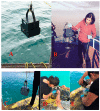Arsenic Pollution and Anaerobic Arsenic Metabolizing Bacteria in Lake Van, the World's Largest Soda Lake
- PMID: 36431035
- PMCID: PMC9694729
- DOI: 10.3390/life12111900
Arsenic Pollution and Anaerobic Arsenic Metabolizing Bacteria in Lake Van, the World's Largest Soda Lake
Abstract
Arsenic is responsible for water pollution in many places around the world and presents a serious health risk for people. Lake Van is the world's largest soda lake, and there are no studies on seasonal arsenic pollution and arsenic-resistant bacteria. We aimed to determine the amount of arsenic in the lake water and sediment, to isolate arsenic-metabolizing anaerobic bacteria and their identification, and determination of arsenic metabolism. Sampling was done from 7.5 m to represent the four seasons. Metal contents were determined by using ICP-MS. Pure cultures were obtained using the Hungate technique. Growth characteristics of the strains were determined at different conditions as well as at arsenate and arsenite concentrations. Molecular studies were also carried out for various resistance genes. Our results showed that Lake Van's total arsenic amount changes seasonally. As a result of 16S rRNA sequencing, it was determined that the isolates were members of 8 genera with arsC resistance genes. In conclusion, to sustain water resources, it is necessary to prevent chemical and microorganism-based pollution. It is thought that the arsenic-resistant bacteria obtained as a result of this study will contribute to the solution of environmental arsenic pollution problems, as they are the first data and provide the necessary basic data for the bioremediation studies of arsenic from contaminated environmental habitats. At the same time, the first data that will contribute to the creation of the seasonal arsenic map of Lake Van are obtained.
Keywords: Lake Van; anaerobic bacteria; arsenate; arsenic pollution; arsenite.
Conflict of interest statement
The authors declare no conflict of interest.
Figures









References
-
- Zavarzina D.G., Tourova T.P., Kolganova T.V., Boulygina E.S., Zhilina T.N. Description of Anaerobacillus alkalilacustre gen. nov., sp. nov.—strictly anaerobic diazotrophic Bacillus isolated from soda lake and transfer of Bacillus arseniciselenatis, Bacillus macyae, and Bacillus alkalidiazotrophicus to Anaerobacillus as the new Combinations A. arseniciselenatis comb. nov., A. macyae com. nov., and A. alkalidiazotrophicus com. nov. Microbiology. 2009;78:723–731.
-
- Valdés N., Rivera-Araya J., Bijman J., Escudero L., Demergasso C., Fernández S., Ferrer A., Chávez R., Levicán G. Draft genome sequence of Nitrincola sp. strain A-D6, an arsenic resistant Gammaproteobacterium isolated from a salt flat. Genome Announc. 2014;2:1–2. doi: 10.1128/genomeA.01144-14. - DOI - PMC - PubMed
-
- Stolz J., Basu P., Oremland R. Microbial transformation of elements: The case of arsenic and selenium. Int. Microbiol. 2002;5:201–207. - PubMed
-
- Krumova K., Nikolovski M., Groudeva V. Isolation and identification of arsenic-transforming bacteria from arsenic contaminated sites in Bulgaria. Biotechnol. Biotechnol. EQ. 2008;22:721–728. doi: 10.1080/13102818.2008.10817541. - DOI
Grants and funding
LinkOut - more resources
Full Text Sources
Research Materials

